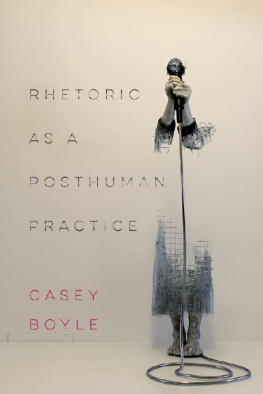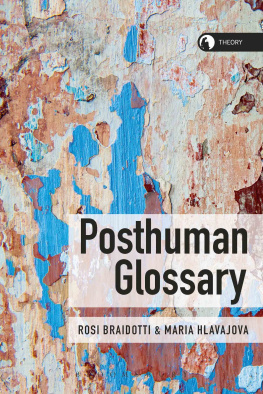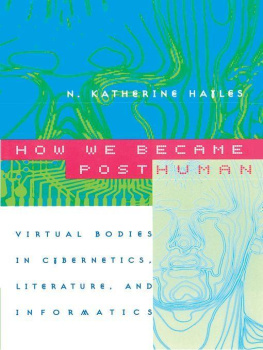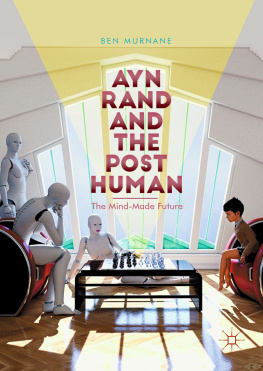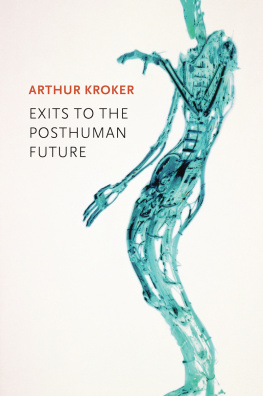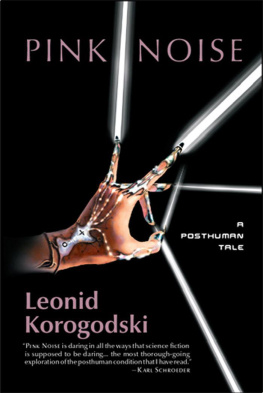One could hardly mention everybody who has contributed to the creation of this book. I would like to thank the former president of the University of Lower Silesia, Professor Robert Kwanica, for his support for the first study trip on this project. Without the hospitality of Donna Kowal of SUNY College at Brockport that trip could not have happened. I extend a big thank you to Richard Smith, the former director of the Centre for Digital Media in Vancouver, and the Centres other staff who gave me a warm welcome on my second trip to North America. It is thanks to them that I was able to finish the book. My gratitude goes also to all those who have left their direct or indirect imprint on this tome: Beata Sierocka, Ireneusz Sierocki, Stefan Bednarek, Sonia Fizek, Maciej Sedlaczek, Maciej Czerniakowski, Carmel Vaisman, Francesca Ferrando and Stefan Lorenz Sorgner. I received a wealth of precious feedback from Krystina Madej, Bert Olivier, Evi Sampanikou and Curtis D. Carbonell.
I thank especially my publisher, Katie Gallof of Bloomsbury Academic, for her propitious support for me and my project ever since I first approached the publisher with it.
As is often the case when working on academic projects, the help received from others also has other dimensions than the purely academic aspects of the work. For this reason I would like to thank Agnieszka Chodorowska, Tom Kowal, Wojciech Wojciechowski and Magorzata Wojciechowska, Kathy and Henry Herdzik, Stanisaw Figaj, Danuta Adziska and Alek Bester, Katarzyna and Tomasz emojtel.
Last but not least, my greatest thanks go to my wife, children, parents and parents in-law, without whom this posthuman adventure could not have been a success.
Is it possible to show affection for immaterial objects? Is it possible to place our feelings in algorithms, digital representations, images and sounds? Can media content become a lover or friend, or a conscious or unconscious oppressor? What of our lust, hate, fear and other emotions when they are filtered and mediatized by modern digital vehicles such as the internet, virtual reality or video games? What of our humanity when its limits are constantly undermined by material and immaterial transfers of stimuli, affects and cravings? Who controls the transfers and who benefits from them? Who or what is the non-human other situated in the media apparatus?
All of these questions surface more and more frequently in the public space in a time of increasingly sophisticated AI scripts, developing companion bots or sex-bots, fictional characters and avatars taking the place of physical human subjects. These trends contribute to the emergence of highly complex posthuman intimacy and emotionality. Their biological, technological and informational elements together construct complicated and vivid assemblages, and have for a long time formed hybrid subjects of either material or immaterial structure, often called human, or otherwise.
It turns out, however, that this melting away and reconfiguration of intimacy and the associated subject idea of a diversity of apparatus of pain and pleasure is not just a characteristic feature of our own post-digital age but appears to have been presented in many historical media orders. The greater, therefore, the perceived importance of their analysis, for we then understand the evolution of media technologies as an unending, perennial game of formation of nomadic subjecthood constituting the product of autonomy and subordination, algorithmic action patterns and spontaneous entropy, as well as the dynamic relationship between subjectivation and objectification.
Posthuman intimacy thus seems to be an incredibly important category capable of showing, in an interesting light, the deep time of media, as Siegfried Zielinski writes, from an archaeological perspective (or anarchaeological, rather). Such a close look on both media pasts and the media present through the lens of posthuman affects and assemblages is what I would like to make the subject matter of this book.
The posthuman reflection that is gaining increasing popularity is currently practised in a great many fields within humanities. The foundational works to this area of thinking by Donna Haraway, Katherine Hayles, Rosi Braidotti, Cary Wolfe or Karen Barad, along with other scholars associated with this current of thought or contributing valuable inspiration to it even before it received its name, delimit various territories of reflection, from technological contexts, wherein the cyborg figure and artificial intelligence have pride of place, through social aspects associated, for example, with the actor-network category, to interspecies relations and bio-art. The various diverse perspectives of employing the posthuman idea in humanities have in many cases a common denominator in the pursuit of demystification of the category of the liberal humanist subject with its own autonomous substantiality (essentiality) and the capacity for self-governance and as a rational and integral being with clearly defined boundaries. The construability and impermanence of that which is human and that which is non-human, the problem of autonomy and ethics, and attempts to redefine the category of the other are subjects of singular importance in the wake of the change brought by the advances in information technologies, digital media, genetic engineering, as well as other problems, e.g. in the area of Foucaltist bio-politics.
Posthuman reflection in its current shape builds on two strong provenances of the other. One of its enduring legs is the category of the animal, the other of the machine. Haraway, in publishing her two manifestos of the cyborg
The purpose of my study in this book will be an attempt to demonstrate that it is possible within posthuman reflection to determine and describe a
The purpose of my study is not so much to discuss the possibility of combined analysis of information systems through a cybernetic perspective enabling structures with each a different ontological status (human subjects, computer systems, ecosystems) to be discussed on a uniform plane, as to show how, in the anthropological sense, such dilution of the boundaries of the human subject may take place under the influence of information. Theses challenging the integrity of this subject are based, inter alia, on pointing towards other species, technologies or other inanimate objects as equiponderant instances. It appears equally important to show to what extent we can so speak of information creations, even though as until now they have not fully been linked with subjectivity, or at least only in select cases, being at that ones in which the analysis is clearly marked with the technological perspective. Here, Hayles cites examples of artificial life, which in itself is defined by technological discourse, but also introduces the interesting category of data humanization.
By contrast, the bilateral process of giving subjecthood the status of immaterial information and on the other hand uplifting informational creations This, too, is one of the reasons why in my book I will strive to highlight these processes in a historical perspective by scrutiny of the media technologies arising prior to the Digital Age.
However the main purpose of my study is to examine the scope of possibility of building subjective relations between the users of the various media technologies and the senses communicated through the latter. I attempt to demonstrate that the relationship between the subject defined as the user of the medium and the meanings generated in the various media environments unfolds between the polar extremes of competition and cooperation. I also describe the terms of that confrontation and the protocols of closeness and emotional bond that are built during it. Hence, this is an attempt to construct a theory of intimacy describing processes occurring between a human subject and information creations. In this book I demonstrate in what way and in what phases that relationship is built and what its nature is. I also examine the valency conditions of the instances described, which work out a common tongue, positioning themselves between the polar extremes of conflict and collaboration.




